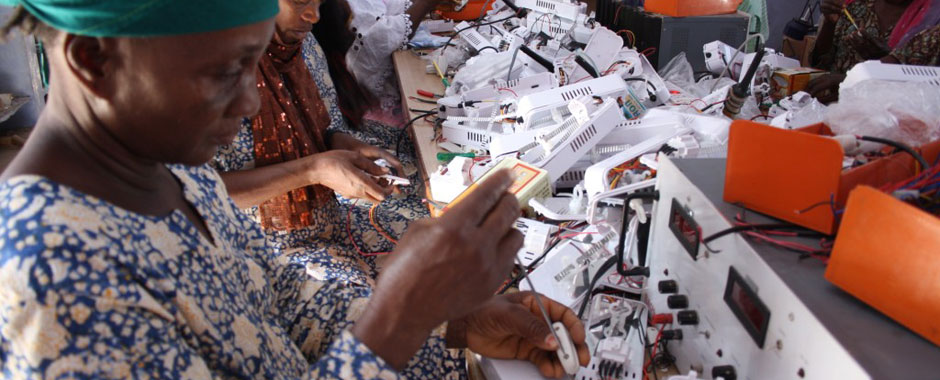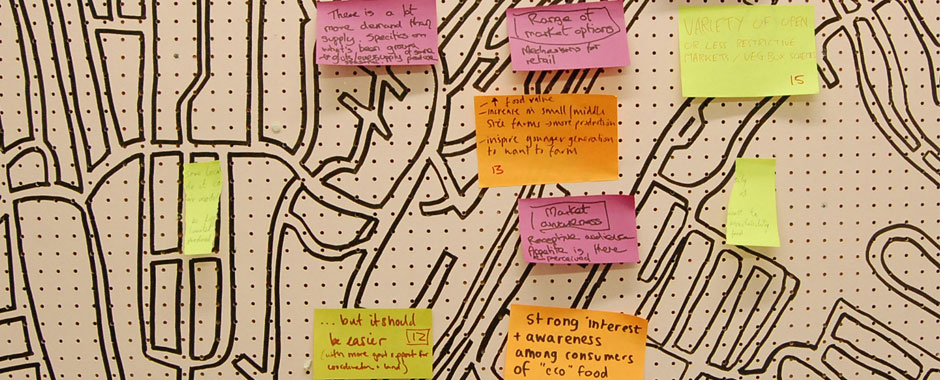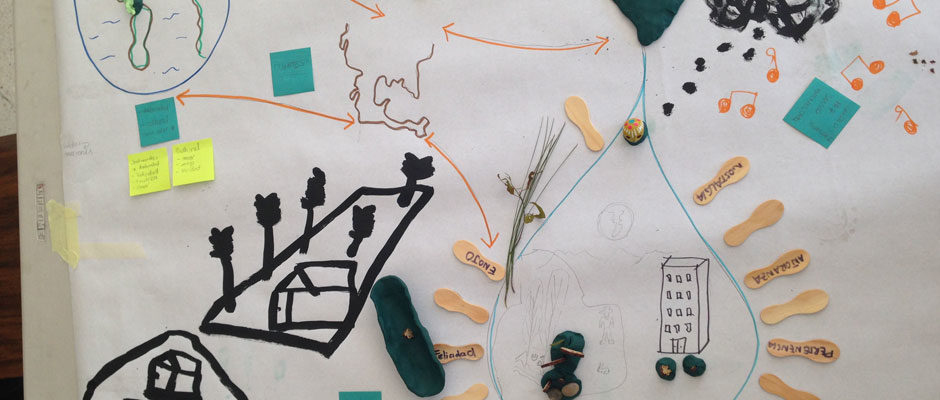The PATHWAYS Network is exploring solutions to problems in six sites (in Argentina, China, Kenya, India, Mexico and the UK) where socio-ecological systems are transforming. To intervene in these transformations, the project is convening multi-stakeholder processes called ‘transformation labs’ (T-Labs) in order to foster change in the systems being studied by each hub.
This approach follows the emphasis of the International Social Science Council, who fund the project, and in particular the ‘Transformations to Sustainability’ programme, on co-production. This note aims to provide an accessible introduction to the concept of “transformation labs” and the “social innovation lab guide”, and how they are linked, as they are used in the network to set up and run the labs.
Innovations for transformative change in human-environmental interactions
Transformations to sustainability involve fundamental redirections of current human-environmental relationships (also referred to as social-ecological or people-planet interactions).
From local to global scales, evidence is mounting that many human-environmental interactions have become “locked in” to unsustainable pathways that cannot ensure the long-term generation of both critical ecosystem services and human wellbeing (ISSC and UNESCO 2013).
Smaller incremental adaptations in lifestyles, technology, or governance arrangements will not be sufficient to escape such lock-ins. Instead, we need to understand large-scale social change, including political (Scoones et al. 2015) and behavioral change (Osbaldiston and Schott 2012), which address the links between a healthy planet and economic and social development and identify actions for deliberate transformations towards sustainable pathways, at the rate and scale that the global sustainability challenges call for.
How do T-Labs help?
The purpose of the T-Labs is to generate innovations that can overcome lock-ins and create seeds of change with the potential to have a transformative impact on the broader society towards sustainability. This means innovations that can help us deal with major global challenges as highlighted by the UN’s Sustainable Development Goals and create conditions for human wellbeing, today and in the future, while strengthening Earth’s life support system.
The T-Labs aim at supporting the generation of social innovations rather than technological innovations, although it is recognized that technology plays an important role in many social innovations.
What are social innovations?
By social innovations we mean innovations that can fundamentally change the systems that created the problems in the first place (see Westley et al. 2015).
An illustrative example of a social innovation aimed at having systemic impact is India’s Barefoot College. Barefoot College is a non-governmental organization that has ”been providing basic services and solutions to problems in rural communities for more than 40 years, with the objective of making them self-sufficient and sustainable. These ‘Barefoot solutions’ can be broadly categorized into the delivery of Solar Electrification, Clean Water, Education, Livelihood Development, and Activism”. They have spread across the developing world, where women from villages in Africa have traveled to India to learn about the College’s ideas and practices, and graduate students from North America are applying their concepts to indigenous communities in the North.

The Barefoot College was created as a platform for people to learn from each other to solve basic needs. In a Gandhian tradition, with a focus on the poor, the platform enabled the combination of sustainable technologies such as solar technology for heat and light and social projects. The latter includes empowerment of women with a special emphasis on grandmothers, building technical capacity in the illiterate and uneducated communities, empowering children and connecting them with governance, and social entrepreneurship.
As Westley (2013) points out, “such connection and the juxtaposition of elements not normally combined addressed a cluster of intractable problems including the health needs, gender inequalities, environmental problems, energy needs, and educational needs of the developing South.” The Barefoot College’s innovations are deeply radical — challenging the conventions of village life, professional associations, and traditional culture and creating new social-ecological-technological interactions.
In the regions where the hubs are based, we are aiming to use the T-Labs, with their specific focus on human-environmental interactions, and the Social Innovation Lab Guide to generate social innovations that can contribute to concrete, large-scale transformations to sustainability in three broad areas. These are of 1) Sustainable agricultural and food systems for healthy livelihoods, 2) Low carbon energy transitions that serve the needs of the poor, and 3) Waste and water for sustainable cities. Such transformations involve systemic change, which includes changing paradigms and mental models, new political institutions, new physical structures and innovative developments on the ground (Avelino et al. 2014).
Ideas underlying T-labs
The growing interest in “labs” as a tool for achieving large-scale change is promising. Such change labs offer a place for creative, cross-sector and cross-disciplinary decision-making and innovation. The focus is on those ‘‘wicked problems’’ that seem insoluble, and reconciling seemingly antithetical elements such as the need to grow the economy and to maintain environmental services.
Expertise in psychology and group dynamics, complex adaptive systems theory, design thinking and computer modelling and visualisation tools has fed into ideas of change labs. These approaches rely on conditions such as broad-based research (across disciplines and methods), co-creation of solutions (across sectors and including citizens) a specialised physical environment (a ‘safe space’ where participants are more likely to be creative), clear process design and facilitation (including explaining how any particular workshop links to wider changes), rapid prototyping (of the social innovation e.g. testable model, software, plan or intervention to be designed) (see pp. 47-53 in Westley et al. 2015), multi-disciplinary support staff (and facilitators) and continual learning (supporting the roll-out of the lab’s outputs).
The main focus of these labs has been on achieving social change, and more specifically changes in relationships between people and between people and their social environment. However, they tend to miss human-environmental relationships and connectedness between nature and human society, which is particularly important for achieving sustainability transformations.
By decoupling the social and ecological, and examining only partial solutions, the risk is that societies may undergo major transformations in important parts of a system or sectors without improving the overall capacity to learn from, respond to, and manage environmental feedback from dynamic ecosystems (Olsson and Galaz 2012).
The T-labs aim to fill this gap. They aim to provide interactive innovation spaces that allow for experimentation with new social-ecological-technological system configurations and sustainability pathways (pathway creation).
T-lab processes and tools
The T-Labs framing helps guide the lab processes towards a specific focus on people-planet interactions and the Social Innovation Lab Guide (Westley et al. 2015) is meant to provide structure and tools (e. g. system mapping, pp. 26-37) for these processes. The Authors states the following about the Guide:
“This Guide to a Social Innovation Lab is offered as a resource to peers, colleagues, practitioners, leaders from all sectors, and concerned citizens – all who have and/or will participate in change-making processes. One hope for this work is that these ideas on social innovation and these recommendations for new practice will result in a greater sense of agency for those who work on what often seem like impossible aspirations for a different, better world. Probably our greatest hope is that these ideas help to transform the impossible into the possible.”
While this shows the aspirations with these labs, the Guide also states:
“…the lab uses a variety of tools and processes drawn from the rich history of whole system processes and the newly emerging design labs, while adding elements unique to facilitating social innovation. This Social Innovation Lab process facilitates the development of interventions that could allow innovations to have broad impact: It allows for the richness of complex systems to shape decision-making; it includes a suite of tools for exploring and imagining systems as a group; and, it uses techniques for creating and/or identifying pathways for innovations to cross scales.”

As the Guide shows there are flexibility and room for experimentation in the way that these labs can be set up. It can also be used in combination with other tools and methods. For example, the STEPS Centre has produced a section of its website dedicated to methods for accessing broad range of sources of knowledge and opening up pathways to sustainability. These have been used in a wide variety of contexts, including multi-criteria mapping, innovation histories, participatory scenarios and more. Partners can experiment with these or other methods in their T-labs, but we are keen that such experimentation is documented by partners (through summaries and/or case studies) and contribute to improving processes and tools over the next three years.
In preparation for the inception meeting in Buenos Aires we asked the hubs to think about the following considerations:
- The title of the T-Lab
- What is the problem you try to solve and how does it link to the definitions of transformation and social innovation stated earlier?
- Describe the co-design process and the intended participants. What sectors or groups do they represent and why are they invited?
- Describe the facilitation of the co-design process. Which method will be used and who will facilitate?
- What are the potential prototypes and impact of these? Describe how the innovations are meant to fundamentally change human-environmental interactions and contribute to large-scale changes.
- What would be signs of success? How will you monitor this?
These questions helped to frame the discussion between the hubs about how they would use the lab thinking in their cases. They also revealed how the T-Lab framing and the Lab Guide, and other resources, were being used in the planning phase and setup of the T-Labs.
The project has carried on this discussion beyond the planning phase. Visits between hubs and ‘co-learning’ blogs have encouraged a continuous discussion and sharing of experiences and insights on prepping and initiating change labs throughout the ISSC program.
Different contexts, different approaches
We were aware that change labs have primarily been used in North America and Western Europe (although there are a growing number of exceptions, including RLabs in South Africa). We are keen to experiment with these approaches in the other regions where the network is based, and to learn from the experiences and strategies of co-production traditionally used by our partners.
We expected that the ways in which the T-Labs are designed and facilitated would need to differ, based on the relationship between science/ research, policy and the role of citizens in each context. We hope, however, that the key considerations above, and a focus on the role of innovation in contribution to transformations to sustainability, will be central to work in all hubs.
Impact Methods – Monitoring and Learning
As an overarching aim of the project is to understand the role that social science and co-production (through T-Labs) can play in helping to bring about transformations, we needed to plan our work with this in mind, and learn from the experiences that the project provides. How do we keep track of the process outcomes? What do we measure? How do we monitor transformative change that addresses both social and ecological dimensions and the interactions between them?
At the inception meeting for the project, we used one particular method called Participatory Impact Pathways Analysis (PIPA)(Ely and Oxley 2014) to help partners plan the co-production processes and their impacts. This aimed to help us to think through the ways in which we organised T-Labs, including the people to convene, the methods to use and the strategies to ensure that the T-Labs contribute to long-term change.
The PIPA has been used alongside a survey (organised by Anabel Marin and Adrian Ely) to help us understand whether/how the T-Labs can contribute to large-scale systemic changes (for example from the local up to the international level). This will provide useful information to the wider Future Earth programme and to the wider academic literature in this area, as well as making an important contribution to thinking and action around the UN’s Sustanable Development Goals.
For more information on the project, and updates on the progress of the T-Labs, visit the PATHWAYS Network homepage.
References
- Avelino, F. Wittmayer, J., Haxeltine, A., Kemp, R., O’Riordan, T., Weaver, P., Loorbach, D. and Rotmans, J. (2014) Game-changers and Transformative Social Innovation. The Case of the Economic Crisis and the New Economy, TRANSIT working paper, TRANSIT: EU SSH.2013.3.2-1 Grant agreement no: 613169.
- Ely, A. and Oxley, N. (2014) STEPS Centre Research: Our Approach to Impact, STEPS Working Paper 60, Brighton: STEPS Centre
- ISSC and UNESCO. 2013. World Social Science Report 2013, Changing Global Environments, OECD Publishing and UNESCO Publishing, Paris.
- Olsson, P., and V. Galaz. 2012. Social-ecological innovation and transformation. Pages 223-243 in A. Nicholls and A. Murdoch, editors. Social innovation: blurring boundaries to reconfigure markets. Palgrave MacMillan, Basingstoke, UK. http://dx.doi.org/10.1057/9780230367098.0018
- Osbaldiston, R., & Schott, J. P. 2012. Environmental sustainability and behavioral science: Meta-analysis of pro-environmental behavior experiments. Environment and Behavior 44:257–299
- Scoones, I., Leach, M. and Newell, P. (editors). 2015. The Politics of Green Transformations. Routledge, Oxon
- Westley, F. 2013. Social innovation and resilience: how one enhances the other. Stanford Social Innovation Review. Sponsored supplement to SSIR. Summer 2013
- Westley, F., S. Laban et al (2015) The University of Waterloo social innovation lab guide
